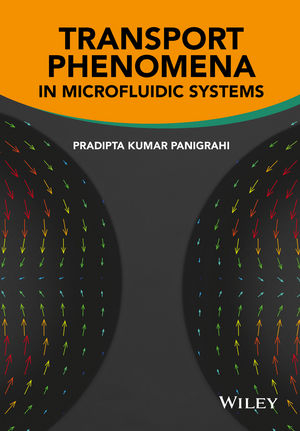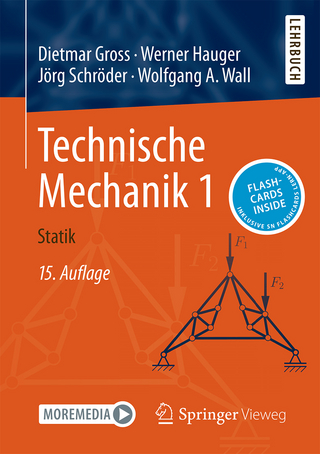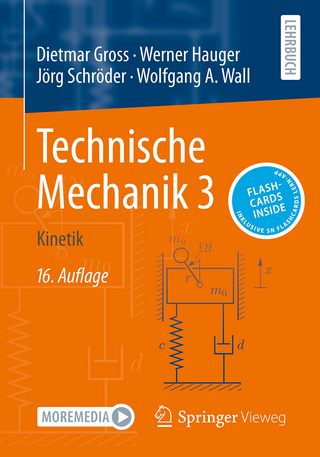
Transport Phenomena in Microfluidic Systems
John Wiley & Sons Inc (Verlag)
9781118298411 (ISBN)
- Titel z.Zt. nicht lieferbar
- Versandkostenfrei
- Auch auf Rechnung
- Artikel merken
Fully comprehensive introduction to the rapidly emerging area of micro systems technology
Transport Phenomena in Micro Systems explores the fundamentals of the new technologies related to Micro-Electro-Mechanical Systems (MEMS). It deals with the behavior, precise control and manipulation of fluids that are geometrically constrained to a small, typically sub-millimeter, scale, such as nl, pl, fl, small size, low energy consumption, effects of the micro domain and heat transfer in the related devices. The author describes in detail and with extensive illustration micro fabrication, channel flow, transport laws, magnetophoresis, micro scale convection and micro sensors and activators, among others. This book spans multidisciplinary fields such as material science and mechanical engineering, engineering, physics, chemistry, microtechnology and biotechnology.
Brings together in one collection recent and emerging developments in this fast-growing area of micro systems
Covers multidisciplinary fields such as materials science, mechanical engineering, microtechnology and biotechnology, et al
Comprehensive coverage of analytical models in microfluidics and MEMS technology
Introduces micro fluidics applications include the development of inkjet printheads, micro-propulsion, and micro thermal technologies
Presented in a very logical format
Supplies readers with problems and solutions
Pradipta Panigrahi is a professor and head of the Centre for Laser Technology, IIT Kanpur. He obtained his PhD in Mechanical Engineering from Louisiana State University, USA, in 1997. He was awarded a master degree at Louisiana State University in mechanical engineering in 1993 and another master in system science in the same institution in 1997. He obtained his B.Sc degree in echanical engineering at UCE Burla, Sambalpur University, India. His areas of interest include optical techniques, turbulence, hot wire anemometry, Color Schlieren and design of thermal systems. He has published over 100 international journals, books and conference proceedings on a range of subjects including digital holography, particle image velocimetry, laser interferometry, liquid crystal thermography and soft computing based flow control. He was awarded the Swarnajayanti Fellowship by the Department of Science and Technology (India) in 2006. In 1981, Dr. Panigrahi was awarded the National Scholarship.
About the Author xv
Preface xvii
Acknowledgement xix
List of Figures xxi
List of Tables xxxvii
1 Introduction 1
1.1 History 1
1.2 Definition 2
1.3 Analogy of Microfluidics with Computing Technology 2
1.4 Interdisciplinary Aspects of Microfluidics 3
1.5 Overall Benefits of Microdevices 6
1.6 Microscopic Scales for Liquids and Gases 10
1.7 Physics at Micrometric Scale 11
1.8 Scaling Laws 13
1.9 Shrinking of Human Beings 19
2 Channel Flow 23
2.1 Introduction 23
2.2 Hydraulic Resistance 23
2.3 Two Connected Straight Channels 24
2.4 Equivalent Circuit Theory 26
2.5 Reynolds Number 27
2.6 Governing Equation for Arbitrary-Shaped Channel 30
2.7 Summary of Hydraulic Resistance in Straight Channels 40
2.8 Viscous Dissipation of Energy 41
2.9 Compliance 45
3 Transport Laws 51
3.1 Introduction 51
3.2 Boundary Slip 51
3.3 Slip Flow Boundary Condition in Gases 52
3.4 Slip Flow Boundary Condition in Liquids 57
3.5 Physical Parameters Affecting Slip 66
3.6 Possible Liquid Slip Mechanism 67
3.7 Thermal Creep Phenomena 68
3.8 Couette Flow with Slip Flow Boundary Condition 70
3.9 Compressibility Effect in Microscale Flows 74
3.10 Slip Flow between Two Parallel Plates 78
3.11 Fluid Flow Modeling 81
4 Diffusion, Dispersion, and Mixing 101
4.1 Introduction 101
4.2 RandomWalk Model of Diffusion 101
4.3 Stokes–Einstein Law 103
4.4 Fick's Law of Diffusion 103
4.5 Diffusivity and Mass Transport Nomenclature 104
4.6 Governing Equation for Multicomponent System 105
4.7 Characteristic Parameters 107
4.8 Diffusion Equation 109
4.9 Taylor Dispersion 113
4.10 Micromixer 117
4.11 Convective Diffusion 123
4.12 Detailed Analysis 127
4.13 Reverse Osmosis 135
5 Surface Tension-Dominated Flows 149
5.1 Surface Tension 149
5.2 Gibbs Free Energy and Surface Tension 151
5.3 Microscopic Model of Surface Tension 151
5.4 Young–Laplace Equation 152
5.5 Contact Angle 154
5.6 Dynamic Contact Angle 156
5.7 Superhydrophobicity and Superhydrophilicity 158
5.8 Microdrops 163
5.9 Capillary Rise and Dimensionless Numbers 166
5.10 Coating Flows 169
5.11 Enhanced Oil Recovery 171
5.12 Classification of Surface Tension Gradient-Driven Flow 172
5.13 Boundary Conditions 173
5.14 Thermocapillary Motion 174
5.15 Diffusocapillary Flow 177
5.16 Electrowetting 178
5.17 Marangoni Convection in Drops 181
5.18 Marangoni Instability 182
5.19 Micropropulsion System 184
5.20 Capillary Pump 186
5.21 Thermocapillary Motion of Droplets 188
5.22 Thermocapillary Pump 189
5.23 Taylor Flows 192
5.24 Two-Phase Liquid–Liquid Poiseuille Flow 197
5.25 Hydrodynamics of Taylor Flow 199
5.26 Plug Motion in Capillary 201
5.27 Clogging Pressure 203
5.28 Digital Microfluidics 206
6 Charged Species Flow 213
6.1 Introduction 213
6.2 Electrical Conductivity and Charge Transport 214
6.3 Electrohydrodynamic Transport Theory 217
6.4 Electrolytic Cell Example 220
6.5 The Electric Double Layer and Electrokinetic Phenomena 226
6.6 Debye Layer Potential Distribution 228
6.7 Electrokinetic Phenomena Classification 232
6.8 Electroosmosis 233
6.9 Exact Expression for Cylindrical Channel EO Flow 237
6.10 EO Pump 242
6.11 EO Flow in Parallel Plate Channel 249
6.12 Electroosmosis and Forced Convection 252
6.13 Electrophoresis 255
6.14 Dielectrophoresis 259
6.15 Polarization and Dipole Moments 260
6.16 Point Dipole in a Dielectric Fluid 262
6.17 Dielectric Sphere in a Dielectric Fluid: Induced Dipole 264
6.18 Dielectrophoretic Force on a Dielectric Sphere 265
6.19 Dielectrophoretic Trapping of Particles 266
6.20 AC Dielectrophoretic Force on a Dielectric Sphere 268
7 Magnetism and Microfluidics 277
7.1 Introduction 277
7.2 Magnetism Nomenclature 277
7.3 Magnetic Beads 280
7.4 Magnetic Bead Characterization 280
7.5 Magnetostatics 282
7.6 Magnetophoresis 283
7.7 Magnetic Force on Particles 286
7.8 Magnetic Particle Motion 287
7.9 Magnetic Field Flow Fractionation 290
7.10 Ferrofluidic Pumps 293
7.11 Magnetic Sorting and Separation 294
7.12 Magneto-Hydrodynamics 295
7.13 Governing Equations for MHD 296
8 Microscale Conduction 303
8.1 Introduction 303
8.2 Energy Carriers 304
8.3 Scattering Mechanism 305
8.4 Nonequilibrium Conditions 306
8.5 Time and Length Scales 306
8.6 Scale Effects 307
8.7 Fourier’s Law 309
8.8 Hyperbolic Heat Conduction Equation 310
8.9 Kinetic Theory 314
8.10 Heat Capacity 316
8.11 Boltzmann Transport Theory 322
8.12 Microscale Two-Step Models 326
8.13 Thin Film Conduction 327
9 Microscale Convection 331
9.1 Introduction 331
9.2 Scaling Analysis 331
9.3 Laminar Fully Developed Nusselt Number 334
9.4 Why Microchannel Heat Transfer 334
9.5 Gases versus Liquid Flow in Microchannels 335
9.6 Temperature Jump 336
9.7 Couette Flow with Viscous Dissipation 340
9.8 Isothermal Parallel Plate Channel Flow without Viscous Heating 343
9.9 Large Parallel Plate Flow without Viscous Heating: Uniform Surface Flux 346
9.10 Fully Developed Flow in Microtubes: Uniform Surface Flux 352
9.11 Convection in Isothermal Circular Tube with Viscous Heating 358
9.12 Flow Boiling Heat Transfer in Mini-/Microchannels 361
9.13 Condensation Heat Transfer in Mini-/Microchannel 368
10 Microfabrication 375
10.1 Introduction 375
10.2 Microfabrication Environment 376
10.3 Functional Materials 377
10.4 Surface Preparation 383
10.5 General Micromachining Procedure 384
10.6 Photolithography 386
10.7 Subtractive Techniques 391
10.8 Additive Techniques 399
10.9 Example of a Silicon Membrane Fabrication 403
10.10 PDMS-Based Molding 404
10.11 Sealing 407
10.12 Laser Microfabrication Techniques 409
11 Microscale Measurements 417
11.1 Introduction 417
11.2 Microscale Velocity Measurement 417
11.3 PIV Fundamentals 418
11.4 Micro-PIV System 427
11.5 Temperature Measurement 437
12 Microscale Sensors and Actuators 455
12.1 Introduction 455
12.2 Flow Control 455
12.3 Actuator Classification 458
12.4 Shear Stress Sensors 468
12.5 Classification of Shear Stress Sensors 470
12.6 Calibration of Shear Stress Sensors 480
12.7 Uncertainty and Noise 485
13 Heat Pipe 487
13.1 Introduction 487
13.2 Applications of Heat Pipe 487
13.3 Advantages of Heat Pipe 488
13.4 Heat Pipe Operation 488
13.5 Wick Structure 489
13.6 Working Fluids and Structural Material of Heat Pipe 491
13.7 Operating Temperature of Heat Pipe 492
13.8 Ideal Thermodynamic Cycle of Heat Pipe 493
13.9 Microheat Pipe 493
13.10 Effective Thermal Conductivity 495
13.11 Operating Limits 495
13.12 Cleaning and Charging 506
Reference 506
Supplemental Reading 506
Index 507
| Verlagsort | New York |
|---|---|
| Sprache | englisch |
| Maße | 175 x 252 mm |
| Gewicht | 953 g |
| Themenwelt | Naturwissenschaften ► Physik / Astronomie ► Mechanik |
| Naturwissenschaften ► Physik / Astronomie ► Strömungsmechanik | |
| Technik ► Elektrotechnik / Energietechnik | |
| Technik ► Maschinenbau | |
| ISBN-13 | 9781118298411 / 9781118298411 |
| Zustand | Neuware |
| Informationen gemäß Produktsicherheitsverordnung (GPSR) | |
| Haben Sie eine Frage zum Produkt? |
aus dem Bereich


